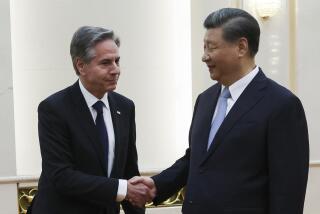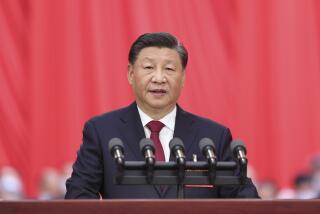CHRONOLOGY OF CHINESE CRISIS:
- Share via
April 15 -- Former Communist Party chief Hu Yaobang, a leading reformer, dies. Students at Beijing University put up posters praising him and indirectly criticizing his opponents who forced his resignation in early 1987 after student demonstrations in 1986-87.
April 17 -- Thousands of students march in Beijing and Shanghai shouting, “Long live Hu Yaobang! Long live democracy! Long live freedom! Long live the rule of law!”
April 18 -- About 2,000 students from Beijing head into Tian An Men Square by bicycle, continuing the protest sit-in at Great Hall of the People. They demand repudiation of past official campaigns against liberalism, press freedom, more money for education and abolition of regulations against demonstrations. They also want leaders to reveal their incomes and reassess Hu.
April 19 -- Students demonstrate in front of the Communist Party headquarters. Police break up the protest and escort them back to campus.
April 21 -- Up to 100,000 gather in Tian An Men Square to mourn Hu.
April 22 -- While official memorial ceremonies are held for Hu at nearby Great Hall of the People, students defy police orders to leave the square. Tens of thousands join them on the square. Riots break out in the provincial capitals of Xian and Changsha. Independent newspaper in Shanghai taken over by authorities.
April 24 -- Tens of thousands of students at Beijing universities go on strike, demanding dialogue with the government. Soldiers reportedly move into Beijing.
April 26 -- The People’s Daily newspaper says in an editorial the students are involved in a “planned conspiracy” led by those with ulterior motives to “throw society into chaos.” This harsh attack by the party newspaper becomes a major student grievance.
April 27 -- More than 50,000 students, with wide support from people on the street, surge past police lines and fill Tian An Men Square, chanting slogans for democracy and freedom.
May 4 -- About 100,000 students and supporters march on Tian An Men Square to celebrate the 70th anniversary of China’s first student movement. Demonstrations are held in Shanghai, Nanjing and other cities. About 300 journalists protest outside the official New China News Agency.
May 5 -- Some students start returning to classes. Communist Party chief Zhao Ziyang calls for dialogue.
May 9 -- Journalists petition the government for press freedom.
May 13 -- About 2,000 students begin hunger strike in Tian An Men Square.
May 14 -- Thousands flock to the square to back the students. The number fasting rises to 3,000.
May 15 -- Government deadline for students to leave the square comes and goes. Welcoming ceremony for visiting Soviet President Mikhail S. Gorbachev must be moved from the square to the airport as crowds swell.
May 16 -- Hundreds of thousands occupy the square as Gorbachev and senior leader Deng Xiaoping meet at nearby Great Hall of the People in historic Sino-Soviet summit. Journalists and intellectuals join the protest.
May 17 -- Zhao makes pre-dawn plea for students to leave. Students reject his appeal, and hold mass marches which generate 1 million supporters in Beijing. Protests held in Shanghai and at least 20 other cities.
May 18 -- About 1 million people, including many workers, again take to Beijing streets to show their support for the hunger strikes. Premier Li Peng issues a stern lecture to student leaders and refuses to discuss their demands.
May 19 -- A tearful Zhao makes a pre-dawn visit to weakened hunger strikers. Li also visits the students briefly. In the evening the students decide to end the hunger strike.
May 20 -- Students change their minds about ending the hunger strike when Li and President Yang Shangkun announce that the military will end the student demonstrations. Zhao reportedly offers to resign after failing to persuade Li and others to compromise.
More to Read
Sign up for Essential California
The most important California stories and recommendations in your inbox every morning.
You may occasionally receive promotional content from the Los Angeles Times.













